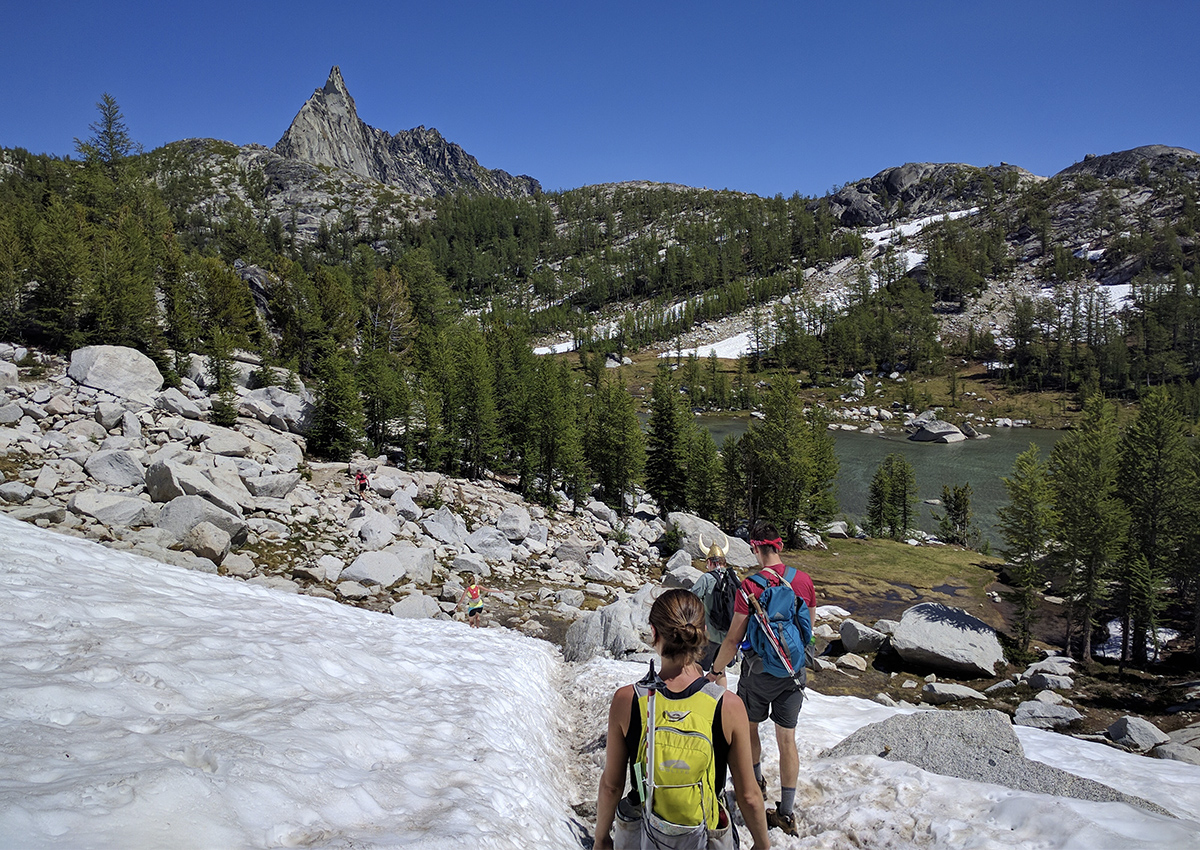Best 2-Person Tents of 2024, Tested and Reviewed
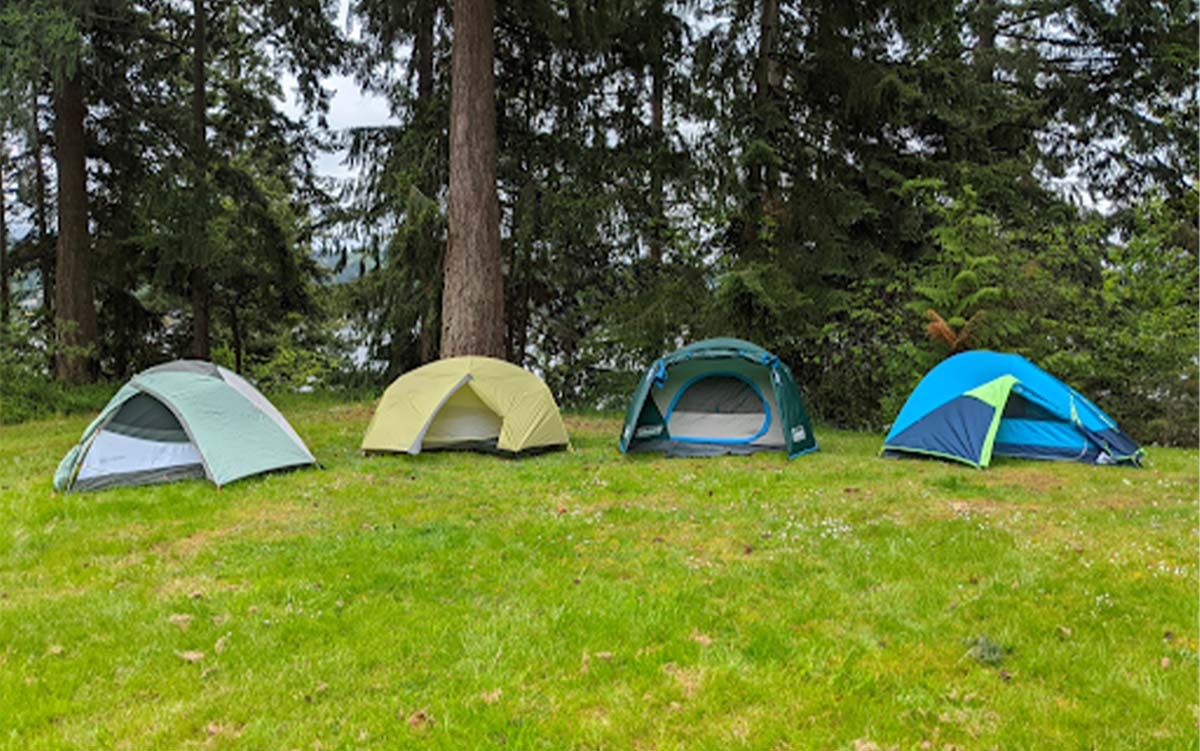
We may earn revenue from the products available on this page and participate in affiliate programs. Learn More ›
With hundreds of 2-person tents on the market, built for everything from car camping to roof tops, mountaineering to ultralight hunting, it can be hard to know where to start. However, over the last several months the Outdoor Life gear team has been testing tents built for a number of different categories. To ease your search, we narrowed down the field to following best 2-person tents available today:
How I Chose the Best 2-Person Tents
I’ve tried, and watched others try, numerous tents over hundreds of nights in nine different states, pitching them on everything from alpine meadows to old-growth forests while long-distance backpacking to casual car camping. I’ve had my fair share of mishaps in tents, from getting flooded in Southern California to being blown off a sand dune outside of Death Valley, to bringing the wrong poles for my winter tent during a snowshoeing overnight in Olympic National Park.
In addition to my own testing of different models of camping tents suitable for camping, backpacking, and river rafting, The Outdoor Life team has tested the best backpacking tents and best ultralight tents as part of our annual backpacking gear tests on America’s long trails.
Best 2-Person Tents: Reviews & Recommendations
Orijin Media/Zach Montes
Buy from Sea to Summit
Buy from REI
Key Features
- Weight: 5 pounds, 3.6 ounces
- Floor Dimensions: 84.5 inches x 53 inches
- Peak Height: 41 inches
- Number of Poles: One
- A comfortable fit for two people
Pros
- Excellent headroom
- Durable material
Cons
- On the heavy side for backpackers
The truth is that quality 2-person tents, something that will last you for years and see you through all manner of conditions, are expensive. That goes double for tents that are light enough to take backpacking: poles and tent fabrics that are light enough to keep your base weight under 20 pounds while still having what it takes to withstand heavy winds and rains come at a premium.
The Sea to Summit Ikos TR2 does a great job of balancing these considerations. It’s on the pricey side, but its versatility makes it a great choice for someone who wants to experiment with a variety of outdoor activities. It’s roomy enough for car camping. It’s got a small enough packed size for bikepacking. It’s still light enough for traditional-style backpacking. And the 68D floor coupled with a limited lifetime warranty means you can expect to get many years of use out of this tent. The first evening I tested it along the Colorado River some serious winds kicked up. Even tents where the stakes were held down by larger rocks saw movement, and some started to cartwheel away before being rescued by their owners.
The tri-beam stakes (the design of all of the best tent stakes) held where I was able to pound them into the hard packed sand. The nylon webbing survived where I had piled rocks on top of it without visible abrasion. The poles stood firm without issue, and the tent floor looked no worse for wear where it had scraped across the ground. It was an impressive performance.
Its excellent structural design is also notable for having the most headspace of any tent I’ve used. Whereas the center pole of most 2-person tents bend downwards, the Ikos TR2 is designed to bend upward. This maximizes the headspace across the center of the tent, making it that much more comfortable for two people to share.
Alex Robinson 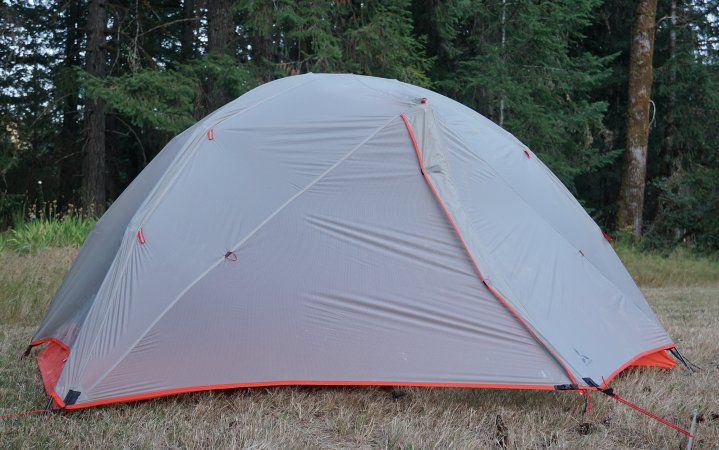
Buy from Slingfin
Key Features
- Max Head Height: 44 inches
- Doors: Two doors
- Materials: Ripstop nylon
- Warranty: Limited lifetime
- Price: $560
Pros
- Great interior space (and pockets)
- Easy to achieve a basic setup
- Multiple ways to make your setup more storm worthy
Cons
- Expensive
- Heavy compared to other models we looked at
At first glance, the Slingfin looks like any other freestanding backpacking tent. Two poles crisscross and connect in at the tent corners. Clip up the body, secure the fly, and you’re done. But while you can absolutely stop there in your set up (and several of the testers on our backpacking gear test did, more on that below), you can also go through any number of additional steps to make an even more bombproof setup for those times when you expect to encounter rough weather.
Our third night testing along the Pacific Crest Trail in Washington State’s Goat Rocks Wilderness was along a completely exposed, hard, non-stakeable ridge. Adam Tycaster, the tester for the Slingfin that night, was not able to utilize a number of the additional options for creating a taut setup with this tent. Nonetheless, while other testers that night reported heavy winds pushing the walls of their tents inward, Tycaster — who did not even get his vestibule fully staked out — experienced no compromise of the tent structure itself.
So that’s what you get with the Portal when you don’t do anything. But in addition to the guylines (attached at the same spot on the rainfly as the pole clips for additional structural integrity), tensioners within the tent allow you to reduce slack without even getting out of your sleeping bag. Unusually for a freestanding tent, you can integrate your trekking poles into the design (at the midpoint on the doors), to add additional structure. You can even purchase more robust poles for this tent, for high-wind environments.
All this makes the Slingfin Portal one of the more interesting backpacking tents that we’ve looked at. It’s an appropriate choice for a beginner just getting started with multi-day trips. It’s also a great choice for experienced backpackers that want a lightweight tent that can perform in multiple environments.
There were also user-friendly features on the inside of the tent. Pocket-enthusiast Patrice “Steady” La Vigne told me, “There were almost too many pockets! I counted two gear lofts, two pockets on each side at the head end, and one large pocket at the feet.” Multiple testers also noted the comparatively high peak interior height, which was 44 inches (nearly 4 feet). Better yet: This tent was roomy enough to fit two average-size men comfortably, making it an appropriate choice for non-romantic hiking partners.
So what’s the bad with this 2-person tent? First off, it’s both a little pricier and a little heavier than other models that Outdoor Life has tested. But in this case, the benefits of this tent — particularly for individuals who expect to camp in exposed locations — outweighs these issues. And compared to the MSR Hubba Hubba or Nemo Dagger — its similarly priced bombproof competitors — it is about a pound lighter.
Best Backpacking: MSR Freelite
MSR 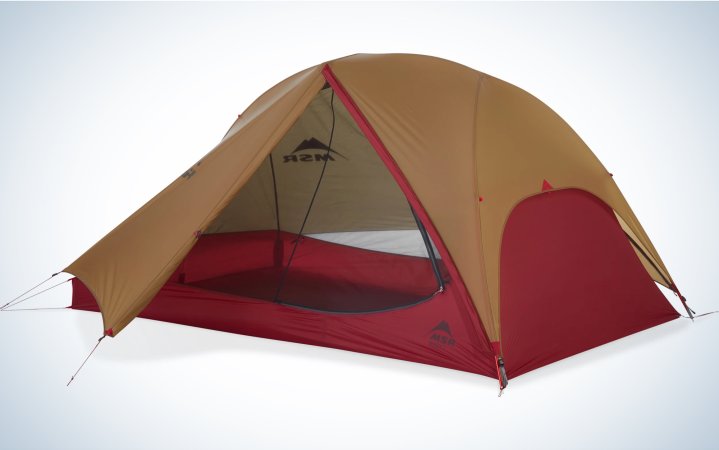
Buy from Amazon
Buy from MSR
Key Features
- Max Head Height: 39 inches
- Doors: Two doors
- Materials: Ripstop nylon
- Warranty: 3 years
- Price: $450
Pros
- One of the lightest semi-freestanding tents we tested
- Good length
- Easy to set up
Cons
- Slightly narrower interior space than other tents at this price point
The MSR Freelite is both semi-freestanding and shockingly light, which is essential for backpackers. Setting up the MSR Freelite (our testing team checked out the one-person model on a trek down a section of the Oregon Coast Trail) was extremely fast, with one tester setting it up in under two minutes on her first try. Similarly, it took minimal effort to achieve a storm-worthy profile. Testers reported that it felt larger than it was, which is an important detail if you get stuck inside waiting out a storm. The mesh and fly are extremely lightweight and plenty robust, with the dirt falling right off when we shook it out before stuffing it away for the day. The poles were even made from aluminum, as opposed to splinter-prone carbon fiber. Our only concern was with that 15D bathtub floor — it may benefit from a groundsheet on more challenging terrains — but this was strictly theoretical as we didn’t experience any holes on our testing trip. The interior, while not exactly spacious, is plenty large enough for two of the biggest sleeping pads on our test (a full-size rectangular Therm-a-Rest NeoAir Xlite NXT), with a backpack fitting handily into the vestibule.
While some backpackers prefer the weight savings of a single-wall tent, the extreme condensation of the Oregon Coast showed the advantages of a double-wall setup. While the rest of our testing team was carefully packing up for the day, avoiding the soaked sides of their single-walled tents lest they unleash a rainstorm on their sleep system, the tester in the MSR Freelite could sit up, bump their head on the mesh at the top of the tent, and stay dry.
There are only a few small quibbles with this tent. One is the doors: They are on the small side compared to the rest of our field, forcing our tallest tester (5 feet, 10 inches) to pretzel her limbs more than she would have liked when getting out. The included stakes (needle stakes) are also lower quality compared to other options in the MSR arsenal. Consider upgrading to either the lightweight MSR Carbon Cores or the MSR Groundhog Minis, which have great holding power.
Best Ultralight: Zpacks Free Zip
Diana Helmuth 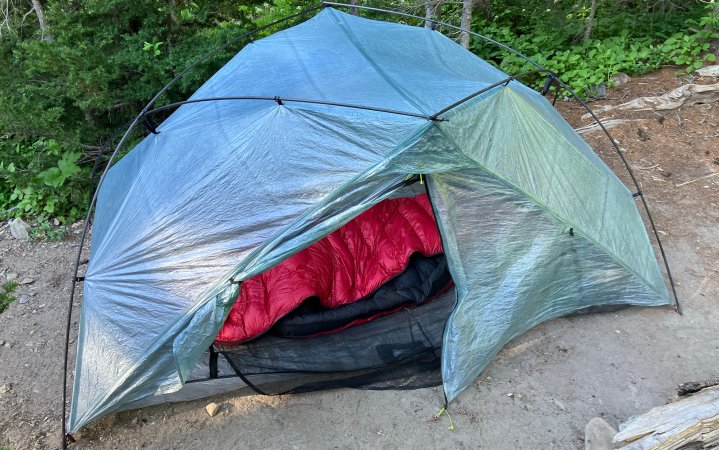
Buy from Zpacks
Key Features
- Max Head Height: 43 inches
- Doors: 2
- Materials: Dyneema
- Warranty: 2 years
- Price: $900
Pros
- Very storm worthy
- Lightweight
Cons
- No vestibule
- Tight squeeze for two people
- Expensive
OL Associate editor Ashley Thess raved about the tent she used on the Tour du Mont Blanc, and, after our testing team had the chance to check out the Zpacks Free Zip, we can see why. Like all semi-freestanding ultralight tents, it takes very little time to set this one up. Unlike other semi-freestanding ultralight tents, you get a surprisingly bombproof pitch with very little tweaking.
Unusually for a 2-person tent, there are four separate pole sections, all the same length. Two poles crisscross to form an X on each side, creating the structure of the tent. All our testers found this to be simple and intuitive. Helmuth, who struggled mightily with the Zpacks Plex Solo, rated the Free Zip a 5 for setup; in fact, it had nearly perfect scores across the board.
In our experience, while it is possible to set up the Zpacks Free Zip without stakes, our testers aren’t recommending it. First off, the tension from the two opposing cross-pole sections wants to clamshell the tent, which is annoying. But even once you get inside it and force the tent shape down with your body weight, you’re going to be missing some floor real estate. The stakes are also essential if you are planning to use this tent in exposed or windy conditions. But once it was properly staked out, testers were impressed with its stormworthiness, with one noting that it “felt like it could withstand a hurricane.”
Whether or not you think the Free Zip has enough interior space depends on your expectations from an ultralight tent. Zpacks rates the smaller model of this tent as being for one to two people (and the larger as being for two to three). Our experience supports this recommendation. While two medium-sized women with ultralight kits were able to fit into this tent together, this one would not fit two average sized men. Another consideration with this tent is condensation. Like all single-wall tents, it’s prone to collecting moisture on the interior, but when fully zipped up it’s even more prone than most: it was one of the few tents on our Goat Rocks Wilderness trek to struggle with condensation (on the second night, while camped next to a river). The lack of vestibules makes this an additional challenge.
The small size of the vestibules are perhaps one of the most noteworthy features of this tent. Their taut design is part of what makes them so stormworthy; however, it also means that you aren’t going to fit much more in there then your shoes. Whether that’s a dealbreaker or a non-issue for you will depend on the size of your existing kit. Magic also noted that the low entrance to this tent was difficult to get in and out for him, due to stiffness from Parkinson’s.
We can’t end this review without mentioning the price. It’s very high (certainly partly due to the high cost of Dyneema and carbon fiber), and likely out of reach for most ultralight backpackers.
Read our full review of the Zpacks Free Zip Tent for more information.
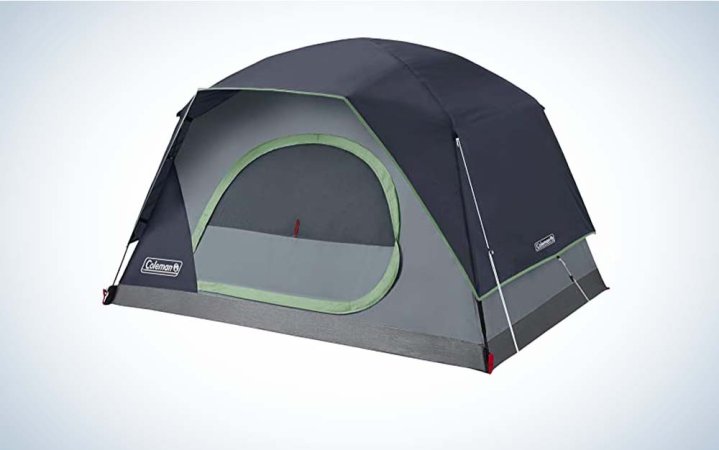
Buy from Amazon
Key Features
- Weight: 9 pounds, 10 ounces
- Floor Dimensions: 84 inches x 60 inches
- Peak Height: 48 inches
- Number of Poles: Three
- A roomy fit for two people
Pros
- Tallest ceiling of any 2-person tent I’ve tested
- Low price
- Heavy-duty bathtub floor excels at keeping puddles at bay
Cons
- Small vestibule door
- Fly setup is less straightforward than the tent
You’ll inevitably spend a little more time in your tent car camping than backpacking. Lazy early mornings, an outfit change after your afternoon hike, pre-dinner nap—so you want a tent that you, and your camping partner, can stretch out in comfortably in. Besides having the most generous square footage of any tent in my test, what set the Coleman Skydome Tent apart from its competition was its height: an impressive four feet. While many 2-person tents only have space for one person, the 60 inches of width means that not only can you fit yourself and your adventure partner (snuggling optional; the tent is wide enough to accommodate a queen-size sleeping pad), but also a four-legged friend. And the best yet? At less than a hundred dollars, this is an extremely affordably priced tent.
The drawback of this tent is that it is less intuitive to set up than others in my test—I had to go back to the directions multiple times to figure it out. The two poles, which are connected to the tent body (a boon to anyone who has ever forgotten their poles at home) snapped into place with the end sliding easily into a pouch on the opposite corner and the tabs clicking into place. But when it came time to put on the rainfly, it took some searching to figure out where the pole slid into the underside of the rainfly. But once it was set up, the trouble was worth it, as this is the best awning I’ve ever seen on a 2-person tent—better than a lot of four-person tents.
Despite being a 2-person tent, the Coleman Skydome only has one door, which is less than ideal if you are on the wrong side of the tent when nature calls in the middle of the night. Worse, the door is pretty small, limiting the view outside the tent on a buggy day. It also has only one dedicated mesh pocket on the interior for stashing odds and ends like headlamps and glasses, while other tents in our test have as many as three per person.
Things to Consider Before Buying a 2-Person Tent
Purpose of the Best 2 Person Tents
Campers can expect to face a variety of conditions depending on the time of year and the part of the country they are exploring, so knowing the extremes of likely conditions is essential for choosing a tent. The tents in this selection are three-season tents, which are appropriate for summer and shoulder-season conditions.
Set-Up of the Best 2 Person Tents
The majority of 2-person tents on the market are freestanding, which means that once you snap poles into their grommets, you’ll have a reasonable approximation of what the final structure will look like. Although, in many cases, staking out the tent will noticeably increase your usable floor space. Freestanding tents are a great choice for first-time tent purchasers, as there tends to be less guesswork during the initial set up. Many of the tents in this roundup also use color coding to signal to first-time users how to correctly align the poles, the tent body, and the rainfly.
Weight of the Best 2 Person Tents
Car camping tents, including pop-up tents and the best rooftop tents, are bulky. Even the lightest models weigh upwards of five pounds per person. The best backpacking tents are much lighter and typically weigh less than three pounds per person, with some ultralight (UL) models approaching one pound or less. There is usually a tradeoff with weight savings for durability and price with backpacking tents. Backpackers focused on short trips may prefer a heavier option while those that plan on high-mileage days would do better with a lightweight model.
Read Next: The Best Ultralight Tents
Size of the Best 2 Person Tents
A major reason individuals look for a 2-person tent is that a one-person tent is typically a tight squeeze for anyone over 5-foot 10 inches—forget about squeezing in your pack and the rest of your gear. It’s not uncommon to see larger individuals opt for 2-person, or even three-person, tents to get enough leg room. But there can also be substantial differences in headroom height between different tents.
Read Next: The Best One-Person Tents
FAQs
Two-person tents range in cost from less than $50 to upwards of $1,000. These price differences typically reflect the quality of material and construction, and, in the case of backpacking tents, weight differences.
Some 2-person tents can easily fit two people; others are more of a squeeze. I’ve indicated in the above awards whether a tent is a roomy fit, a comfortable fit, or a tight fit.
Most tents today have already been waterproofed, otherwise known as seam-sealed. But, over time, the seam-sealing on tents can start to wear down, and will need to be replaced. In a well-ventilated room (such as your garage), set up your tent, but place the rainfly on inside out. Then follow the instructions on your seam sealant (Gear Aid is a popular brand), being careful to avoid the zippers, to anywhere there is stitching on your tent, including where the guylines connect to the tent. When you’re done, simply wait 10 to 15 minutes for everything to dry.
To clean your 2-person tent at the end of your camping season, start by setting it up in a dry, well-ventilated room (such as a garage), and letting it dry overnight. Check the rainfly for any debris that might be stuck to it before packing it away. Next, open the door of your tent body, securing the mesh to the side. Pick up your tent and shake out any debris that is inside. Then, put your tent body away. Finally, inspect your poles and stakes for any debris before packing them into their respective stuff sacks. Store your tent in a dry area to ensure it’s operating in peak condition for next season.
Final Thoughts on the Best 2-Person Tents
There are a wide range of options on the market today for 2-person tents. We recommend choosing the best quality tent that your budget allows, as the weight-savings and reliability will pay dividends over the years.
Read the full article here




